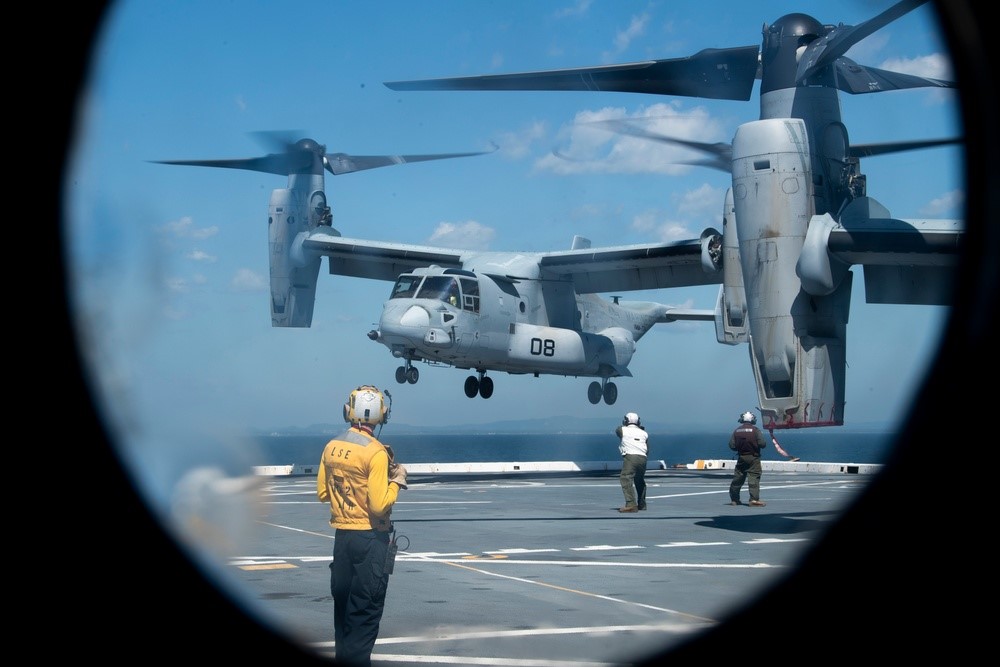
Fleet-wide Ospreys will slowly return to flight after a more than three-month-long grounding following an Air Force CV-22B crash off Japan in November 2023, resulting in the loss of eight airmen. Naval Air Systems Command (NAVAIR) announced the end of the flight ban beginning March 8th and the addition of maintenance and flight training practices to ensure the safe operation of the tiltrotor aircraft.
But even as flight crews return the Osprey to the skies, root issues remain unsolved, and its reputation is no better off. Investigations are ongoing, but preliminary statements from DOD V-22 officials indicate they are unsure why the aircraft continues to manifest a hard-clutch engagement (HCE) problem and an “unprecedented” and unrelated mechanical failure in the fatal November crash.
Despite recent mechanical failures and tragic Osprey accidents that dominated some news sources over the past few months, the V-22 statistically remains a reliable and safe aircraft. A recent Defense One article by Maj. Gen. Steve Busby (USMC, ret.) showed that the V-22’s mishap rate is comparable to other Marine Corps aircraft. As Busby argues, negative perceptions of the Osprey may be influenced by groupthink rather than factual data.
Whether the V-22’s poor public image results from recency or media bias, groupthink, or other reasons is largely beside the point. The DOD has a V-22 reputation problem, facts notwithstanding, and it must fix it.
Much rests on the shoulders of the V-22. The Osprey’s innovative tiltrotor design brings the armed services capabilities unlike any other aircraft. Its “indispensability” to the U.S. military now and for future warfare is widely and well-argued. Aside from the V-22’s critical strategic mission capabilities and successful daily sorties performed by over 400 Ospreys fleet-wide, the aircraft serves as a technological gateway to the future of military rotorcraft.
A Tiltrotor Trailblazer
The Army’s selection of the Bell V-280 Valor for the Future Long-Range Assault Aircraft (FLRAA) program in late 2022 ensures all military departments of the DOD will fly tiltrotor aircraft when the V-280 enters service in the early 2030s. In unit procurement, the V-280 will far exceed total V-22 numbers as the aircraft supplements and then eventually replaces Army UH-60 Black Hawks at a total program cost estimated between $70 and $80 billion. With so much invested, it is crucial the V-22 forges a path for the V-280, and tiltrotor perception plays a role.
The V-280 features a slightly different drivetrain design than the V-22. As it transitions from hovering to forward flight, the prop rotors and gearboxes rotate instead of the engine nacelles like on the Osprey. Ideally, this could reduce wear and strain and require less maintenance than the V-22. Maintenance and training practices for the Bell/Boeing-produced Osprey will surely inform the implementation of the Valor. The two rotorcraft are, in many ways, linked.
Restoring Trust
There is no exact formula, but expert advice on restoring trust in business and relationships revolves around some common themes: Admit mistakes, take accountability, exhibit transparency, and proactively address problems.
Mechanical failures continue to reappear in recent V-22 incidents. After 17 years of service, the inability to rectify issues like HCEs will tarnish the Osprey’s reputation until a full-stop solution. An investigation into an MV-22B crash in 2022 that killed five Marines reported that since 2010, Ospreys suffered 16 similar clutch events. Although the services added preventative maintenance to the input quill assembly, reducing the likelihood of the risk by 99 percent, officials still do not know the root cause.
An aviation truism is that most accidents happen because of pilot error. The Global Accountability Office (GAO) found that human error was the primary causal factor in 95 percent of Class A and B Army National Guard helicopter accidents from FY12 through FY21.* Over the past two years, two of four Class A Osprey crashes appear to be caused by mechanical failures.
While aviation accident statistics require careful analysis due to several factors (accident data is not directly comparable), recent Osprey mishaps seem disproportionately affected by mechanical issues. More in-depth analysis should be released. If mechanical failures represent an outweighed causal factor, then the DOD should announce this clearly.
Course Correcting
A recent auspicious move signals the U.S. Navy is pursuing the right course. The Navy’s FY25 budget request outlines a plan to address Osprey clutch issues, including new gearbox design funding and $138 million for FY26 to purchase kits to replace transmission components. Service officials also suggested they are close to finding the clutch slippage root issue. The plan is welcomed and needed, but it could take years to implement. An approach like this long ago, at the first signs of a problem, could have reinforced trust earlier and potentially headed off future widespread disruptions.
In addition to aggressively and quickly pursuing solutions to mechanical issues, the DOD should reassure the public of the Osprey’s successes and retake control of its branding. A committed campaign to turn the PR tide, driven by data and transparency, could help assuage safety concerns. As of this writing, the House Oversight Committee still awaits a briefing from DOD officials on measures to ensure the Osprey’s safe operation. The committee chairman released a statement a day before the return to flight, citing concerns about adequate “accountability measures” and a “lack of transparency.”
The DOD should prioritize briefing Congress. Though time-consuming and resource-intensive, reassuring lawmakers and the public can help alleviate external pressures, especially when the program faces high-profile media attention. Transparent information sharing could help avoid more assertive congressional regulations. Last December, lawmakers unveiled a plan for strict oversight of the Air Force and Navy’s Next Generation Air Dominance (NGAD) and Collaborative Combat Aircraft (CCA) emerging programs, requiring biannual briefings and detailed cost estimates to ensure accountability. Compliance with congressional requests could be an effective medium for nursing the Osprey’s reputation and shielding against future costly regulation.
The V-22’s bad reputation is not entirely justified. And yet it persists, nonetheless. Failing to guard the aircraft’s image only damages a truly revolutionary and crucial platform. Encouraging strides are underway, but the DOD can and should more deliberately manage and protect the Osprey’s future. There is still time to act.
*For definitions of DOD aviation mishap classes, see Naval Safety Command’s reporting criteria.
A former naval officer and helicopter pilot, Jon covers a range of Forecast International reports and products, drawing on his 10-year background in military aviation, operations, and education. His previous military assignments include multiple overseas deployments supporting operations in the Arabian Gulf, NATO exercises, and humanitarian missions. Jon’s work is also influenced by his time as a former Presidential Management Fellow and international trade specialist at the Department of Commerce.
Before joining Forecast International, Jon also served as an NROTC instructor and Adjunct Assistant Professor at the University of Texas, where he taught undergraduate courses on naval history, navigation, defense organization, and naval operations and warfare. A lifelong reader and learner, his academic and professional interests include aviation, political and military history, national defense and security, and foreign area studies.




